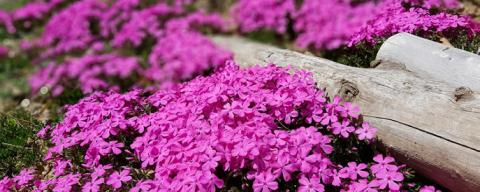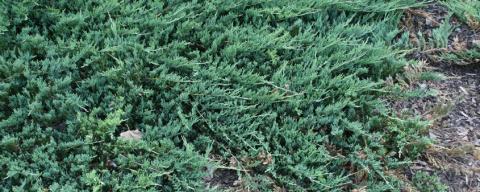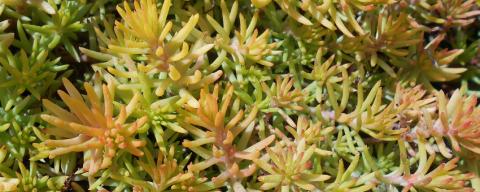Groundcovers are fairly low-growing plants that cover the soil with an abundance of stems and leaves. Turf grass is easily the most widely planted groundcover in the landscape, though it isn’t typically categorized that way. In gardening, the term “groundcover” typically applies to vigorous perennial plants that are used in planting beds.
Benefits of Groundcovers
- Suppress weed growth
- Decrease nutrient leaching during heavy rainfall
- Reduce soil erosion, especially on slopes
- Require less maintenance once established
- Provide cover and forage for pollinators and other wildlife
Plant Selection
- creeping Jenny (Lysimachia nummularia)
- common periwinkle (Vinca minor)
- bishop’s weed (Aegopodium podagraria)
- winter creeper euonymus (Euonymus fortunei).
is possible, but frequent watering is a necessity during hot, dry weather. Plants should be set in the ground at the same level they were in the pot, or slightly higher to account for added mulch. Mulching bare soil between plants is helpful for keeping weeds under control, at least for a season or two until the groundcover becomes established and covers the soil. Mulch will also decrease erosion on slopes until the plant roots are extensive enough to do the job. Two to three inches of coarse organic mulch should be enough to prevent weed seeds from germinating and limit erosion.
Maintenance
List of Groundcovers That Grow Well in New Hampshire
Allegheny spurge (Pachysandra procumbens)
Part to full shade
Moist, organic, well-drained soil. Spreads slowly. Zone 5
Shrubby ground cover that grows 8-12” tall and spreads by rhizomes.
Native to Eastern North America.
Barren strawberry [NATIVE TO NH] (Waldsteinia fragarioides)
Full sun to part shade
Average, well-drained, slightly acidic soil; tolerates a wide range of soil types. Zone 4
Strawberry-like plant that forms 6” tall mats of foliage, spreading by rhizomes. Five-petaled yellow flowers bloom in spring.
Barrenwort (Epimedium species)
Shade to part shade
Dry to medium soil; tolerates drought and growing around tree roots. Zone 5
Rhizomatous, clump-forming perennial. Grows 6-9” tall. Delicate spring flowers can be white, red, pink, purple, or yellow.
Bearberry [NATIVE TO NH] (Arctostaphylos uva-ursi)
Full sun
Acidic, well-drained, dry to medium, sandy soils. Does not need fertilizer. Zone 2
Woody, evergreen, spreading shrub that reaches 6-12” tall.
Drooping white/pink flowers in spring followed by red berries.
Black-eyed Susan(Rudbeckia species)
Full sun
Dry to moist soil. Pre fers consistent moisture but can tolerate drought. Zone 3
Upright, rhizomatous, clumping perennial. Up to 3’ tall. Flowers with yellow petals and brown center disk. Deer resistant.
Bush honeysuckle [NATIVE TO NH] (Diervilla lonicera)
Full sun to part shade
Dry to moist, well-drained soil. Drought tolerant. Zone 3
Suckering, deciduous shrub; 3’ tall by 4’ wide. Clustered tube-like, yellow-orange flowers in spring. Attracts pollinators.
Canada anemone [NATIVE TO NH] (Anemone canadensis)
Full sun to part shade
Medium to wet soil, well-drained soil; tolerates clay. Zone 3
Aggressive herbaceous perennial that grows up to 2’ tall. Deeply divided leaves and showy white flowers. Deer resistant.
Catmint (Nepeta racemosa ‘Walker’s Low’)
Full sun to part shade
Dry, well-drained soil; very drought tolerant. Zone 4
Low, clump-forming perennial; around 24” tall. Whorls of purple two-lipped flowers and aromatic foliage. Deer resistant.
Common bugle (Ajuga reptans)
Full sun to part shade
Average to moist soil. Zone 3
Mat-forming perennial with shiny leaves in various colors. Rarely exceeds 6-8” tall. Whorls of blue flowers in spring.
Cranesbill (Geranium macrorrhizum)
Full sun to part shade
Dry to medium soil; drought tolerant. Zone 4
Rhizomatous perennial, 12-16” tall. Drought tolerant. Deeply divided, aromatic leaves. Purple-pink flowers.
Creeping juniper [NATIVE TO NH] (Juniperus horizontalis)
Full sun
Dry to medium, sandy soil; drought tolerant. Zone 3
Prostrate evergreen shrub; 6-18” tall. Prefers rocky or sandy soils.
Spreads with trailing branches. Blue-green foliage.
Creeping phlox (Phlox stolonifera)
Full sun to part shade
Organic, moist, well-drained soil. Prefers acidic, rich soils. Zone 5
Mat-forming perennial with that spreads by stolons. 6-12” tall. Tubular purple flowers bloom in spring.
Daylily (Hemerocallis)
Full sun to part shade
Average well drained soil. Tolerates a wide range of soil types. Zone 3
Clump forming perennial with blade-like leaves. Flower stalks can reach 1-6’ tall depending on variety. Flowers can be red, orange, yellow, white, pink, or purple.
Dwarf crested Iris (Iris cristata)
Full sun to part shade
Medium to moist soil; drought tolerant. Zone 3
Low-growing perennial that spreads rapidly by rhizomes. 6-18” tall. Pale purple flowers appear in spring.
European wild ginger (Asarum europaeum)
Shade to part shade
Moist, well-drained soil.
Zone 4
Creeping perennial with dark green, kidney-shaped leaves. 4-6” tall. Self-seeds. Flowers at ground level. Deer resistant.
Foam flower [NATIVE TO NH] (Tiarella cordifolia)
Shade to part shade
Medium, well-drained soil; thrives in rich, consistently moist soil.
Zone 4
Clump-forming perennial that spreads by rhizomes. Heart-shaped leaves with 3-5 lobes rise from the ground.
Small, clustered white flowers in spring.
Fragrant sumac [NATIVE TO NH] (Rhus aromatica ‘Grolow’)
Full sun to part shade
Average to dry, well-drained soil; does not tolerate poor drainage.
Zone 3
Low-growing, densely branched shrub. Spreads by suckers. Grows 2-4’ tall. Three-parted leaves have good fall color.
Golden knee (Chrysogonum virginianum)
Shade to part Shade
Moist, acidic, well-drained soils.
Mat-forming perennial that rapidly spreads by rhizomes. Foliage reaches 3-4” tall. Yellow flowers in spring.
Japanese pachysandra (Pachysandra terminalis)
Shade to part shade
Medium moisture, well-drained soil. Tolerates drought and clay soil.
Zone 5
Evergreen, upright perennial that spreads by rhizome. Leaves whorl around stems. Small white flower stalks in spring. 8-12” tall.
Lamb’s ear (Stachys byzantina)
Full sun
Dry to medium, well-drained soil. Zone 4
Perennial that spreads with creeping stems. Bluish, wooly leaves. Flower stalks not especially showy.
Lowbush blueberry [NATIVE TO NH] (Vaccinium angustifolium)
Full sun to part shade
Moist, organic, well-drained, acidic soil. Sandy soil with consistent moisture acceptable.
Zone 2
Deciduous twiggy shrub. Spreads by seed and suckers. 6-24” tall. Red fall color. White, drooping urn-shaped flowers in spring. Edible berries. Attracts wildlife.
Lungwort (Pulmonaria species)
Shade to part shade
Moist, well-drained, organically rich soils.
Zone 3
Creeping perennial that grows 6-12” tall. Dark green foliage with silvery blotches. Funnel-shaped pink and blue flowers. Plant powdery mildew resistant cultivars.
Moss phlox (Phlox subulata)
Full sun
Medium moisture, well-drained soil. Grows well in sandy, dry areas.
Zone 3
Vigorous, mat-forming perennial. Needle-like evergreen foliage. 4-6” tall. Fuchsia, pink, violet, or white flowers in spring.
Pennsylvania sedge [NATIVE TO NH] (Carex pensylvanica)
Shade to part shade
Dry to medium, well-drained soil. Zone 3
Sedge that thrives in dry woodland areas. Clumps grow 6-12” tall. Grasslike foliage. Tolerant of heavy shade.
Russian arborvitae (Microbiota decussata)
Full sun to part shade
Moist, well-drained soil.
Zone 3
Evergreen shrub that grows 6-18” tall. Scalelike foliage held in fanlike sprays. Similar to creeping juniper.
Slender deutzia (Deutzia gracilis ‘Nikko’)
Full sun to part shade
Average, moist, well-drained soil. Tolerates clay soil. Zone 5
Dense, deciduous shrub that grows 2-4’ tall.
Small bell-shaped white flowers in spring.
Stonecrop (Sedum rupestre ‘Angelina’)
Full sun
Dry, well-drained soil. Heat and drought tolerant. Zone 5
Mat-forming perennial that spreads quickly.
4-6” tall. Yellow, cylindrical, pointy, succulent leaves. Yellow flowers in summer.
Sweet fern [NATIVE TO NH] (Comptonia peregrina)
Full sun to part shade
Medium to dry, well-drained soil. Drought tolerant. Zone 2
Deciduous shrub that grows 2-5’ tall. Fragrant, fernlike leaves on upright stems. Fixes its own nitrogen.
Thyme (Thymus serpyllum)
Full sun
Dry or medium moisture, well-drained soil. Drought tolerant. Zone 4
Creeping perennial that grows up to 4” tall.
Thin stems covered with tiny, fragrant leaves.
Purple-pink flowers in summer.
Do you love learning about stuff like this?
SUBSCRIBE TO Granite State Gardening newsletter
Got questions? The UNH Extension Yard and Garden Infoline offers practical help finding answers for your yard and garden questions.
Call toll free at 1-877-398-4769, Monday to Friday, 9 a.m. to 2 p.m., or fill out webform.




